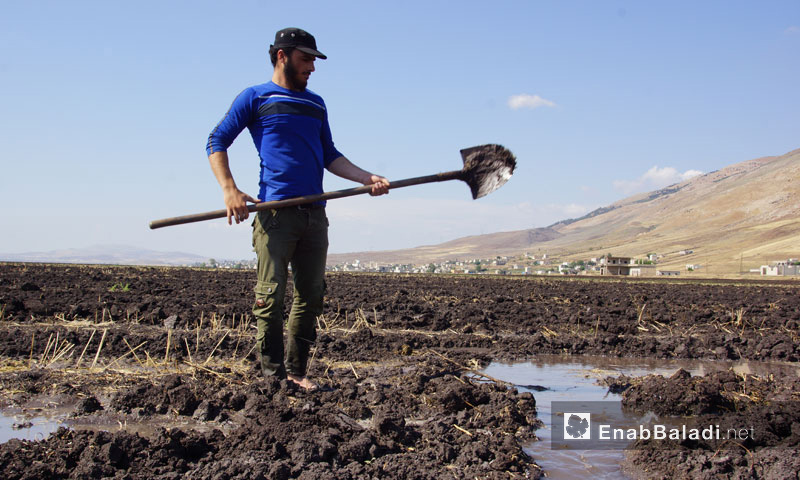The cultivation of cotton has gradually returned to the al-Ghab Plain, rural Hama, following years of absence, to which a number of factors have contributed, including, and most importantly, the inability to secure cotton cultivation means, seeds, fertilizers, irrigation methods and markets, keeping in mind the difficulties faced by the farmers in terms of prices and deteriorating support.
The cultivation of cotton, dubbed “white gold”, in the area has stopped for seven years, coinciding to the farmers’ displacement, as they fled the constant shelling. Displacement did not only affect cotton, but rather it caused the disappearance of several crops, backed by the hardships of providing irrigation water and the running out surface water, and the drought of the Qastun dam’s water, as the agricultural engineer Abdul Jabbar al-Hassan has said.
In an interview with Enab Baladi, al-Hassan attributed the agricultural passivity to other reasons, on top of which are the lack of markets and the unstable security conditions which prevented the farmers from reaching their lands.
The rising agricultural expenses of cultivating cotton if compared to those of other crops has also played a role in the farmers’ abstinence from their craft, according to the head of the local council in the village of el-Zaqum Shuja’ al-Slaeh, who pointed out that farmers, as a less costly solution, could resort to the cultivation of tobacco instead of cotton.
A “Timid” Revival
Cotton cultivation is back to the area after seven years; however, it came back shily.
Mohammad al-Abdullah, a farmer from al-Ghab Plain, estimated the expenses of the process as follows: four thousand Syrian pounds for ploughing the land, as to plant one dunam, 15 thousand for irrigation, nine thousand for fertilizers, ten thousand for the workers’ wages, not to mention the costs of harvesting and transporting the crops.
The production amount of a single dunam has fallen back in comparison to pervious years, for the dunam used to give 500 kilograms, today it gives 300 kilograms only, al-Shaleh said.
Another costly substitute which farmers has utilized for irrigation is aquifers, which depend on the rather expensive fuel; per hour of irrigation using this method costs about three thousand Syrian pounds.
Supporting Organizations Are Also Absent
The return of cotton cultivation into the area was not met with a care that match the importance of the crop. After going back to his land, the area of which is 20 dunams, al-Abdullah complained about the support gap, inquiring: “Where are the concerned organizations, the Coalition, and the Salvation Government who are supposed to support the farmers to be capable of planting larger areas, since the success of the production needs the provision of its success factors, the least of which is loans to encourage the farmers.”
Al-Saleh stressed the absence of the concerned organizations and foundations, pointing out that merchants are lending the farmers the needed supplies for cotton cultivation, seeds and fertilizers, to recover their money when the crops are harvested.
The price of per ton of cotton is 300 thousand Syrian pounds, for, according to al-Saleh, the area planted with cotton in the towns of el-Zaqum, Duqmaq and Qalidin have exceeded the 100 dunams.
Syria ranked second in the world in cotton production in terms of unit area, before the revolution began, and ranked third, at the level of Asia, in the production of organic cotton, but the war played a major role in the decline of production because of the reluctance of farmers to plant as a result of high costs.
Syria’s pre-war cotton production was more than 1 million tons a year, witnessing a 93% decline in the past six years, where production was only 50 to 100 tons in 2015.
Syrians call cotton “white gold” driven by its importance within the Syrian economy; cotton competes with oil in terms of revenues, especially that it used to generate job opportunities for millions of people.
The agricultural engineer Abdul Jabbar al-Hassan said that Syrian cotton stands out as it has a long staple and is used in a number of domestic industries, the most important of which are the manufacture of clothing, oils and medicines. Cotton cultivation is considered one of the strategic crops in the al-Ghab Plain.

